The Whitman walking tour by Jesse Merandy was both informative and inspirational. The weather could not have been better as the air was crisp and the sun was shining as we met at stop number 1: the High Street subway entrance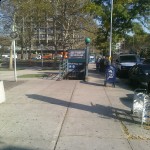 . What was most interesting of this spot was that Whitman himself worked here in the Rome Brother’s Print Shop. I particularly enjoyed this because it evoked for me the memory of reading about his work in the printing shop previously, at the age of 12 written about in Walt Whitman’s New York. In this particular passage he states, “What compositor, running his eye over these lines, but will easily realize the whole modus of that initiation? -the half eager, half bashful beginning- the awkward holding of the stick- the type-box, or perhaps two or three old cases, put under his feet for the novice to stand on, to raise him high enough- the thumb in the stick- the compositor’s rule- the upper case almost out of reach- the lower case spread out handier before him- learning the boxes- the pleasing mystery of the different letters, and their divisions- the great ‘e’ box- the box for spaces right by the boy’s breast- the ‘a’ box, ‘i’ box, ‘o’ box, and all the rest- the box for quads away off in the right hand corner- the slow and laborious formation, type by type, of the first line- its unlucky bursting by the too nervous pressure of the thumb- the first experience in ‘pi’, and the distributing thereof- all this, I say, what journeyman typographer cannot go back in his own experience and easily realize it?” (48). As we proceeded to the second location we passed the housing named after Walt Whitman (44-33 Henry Street)
. What was most interesting of this spot was that Whitman himself worked here in the Rome Brother’s Print Shop. I particularly enjoyed this because it evoked for me the memory of reading about his work in the printing shop previously, at the age of 12 written about in Walt Whitman’s New York. In this particular passage he states, “What compositor, running his eye over these lines, but will easily realize the whole modus of that initiation? -the half eager, half bashful beginning- the awkward holding of the stick- the type-box, or perhaps two or three old cases, put under his feet for the novice to stand on, to raise him high enough- the thumb in the stick- the compositor’s rule- the upper case almost out of reach- the lower case spread out handier before him- learning the boxes- the pleasing mystery of the different letters, and their divisions- the great ‘e’ box- the box for spaces right by the boy’s breast- the ‘a’ box, ‘i’ box, ‘o’ box, and all the rest- the box for quads away off in the right hand corner- the slow and laborious formation, type by type, of the first line- its unlucky bursting by the too nervous pressure of the thumb- the first experience in ‘pi’, and the distributing thereof- all this, I say, what journeyman typographer cannot go back in his own experience and easily realize it?” (48). As we proceeded to the second location we passed the housing named after Walt Whitman (44-33 Henry Street)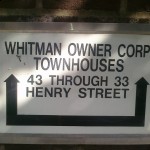 . The second stop, Plymouth Church
. The second stop, Plymouth Church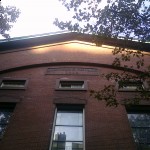 , was moving, especially upon entering the old church. It had the feel of being in the past as one of the students sat in the same row as Lincoln did many years earlier. One of the unusual things about the church was that the stained glass made no reference to angels or gods, they reflected men. The church was known for its involvement in the abolitionist movement and was part of the Underground Railroad. It was striking to me to hear that they had reverse slave auctions in where white people would buy the slaves’ freedom. The curator told us of one particular auction that involved “Pinkie”. Like her name, she was very light skinned, as her father was a white man. Being the daughter of a slave woman, she, despite appearance, was still bound to slavery until her freedom was bought at Plymouth Church. New York Magazine writes, “Most notable was the time a parishioner placed a small gold ring in the offering plate for a young slave girl named Pinkie, who returned to the church in 1927 to give thanks (and to return the ring)”(The Plymouth Church of Pilgrims, http://nymag.com/listings/attraction/plymouth-church-of-the-pilgrims/). Jesse Merandy then lead us down to the Brooklyn Promenade which gave us the vantage point of looking across that river as Whitman did many years ago before the Brooklyn Bridge was built. They say Whitman lived long enough to see the magnificent footings of the bridge constructed, but I am not certain that he ever crossed the bridge. We could see the waterways in which the ferries moved the residents of Brooklyn to the city of Manhattan.
, was moving, especially upon entering the old church. It had the feel of being in the past as one of the students sat in the same row as Lincoln did many years earlier. One of the unusual things about the church was that the stained glass made no reference to angels or gods, they reflected men. The church was known for its involvement in the abolitionist movement and was part of the Underground Railroad. It was striking to me to hear that they had reverse slave auctions in where white people would buy the slaves’ freedom. The curator told us of one particular auction that involved “Pinkie”. Like her name, she was very light skinned, as her father was a white man. Being the daughter of a slave woman, she, despite appearance, was still bound to slavery until her freedom was bought at Plymouth Church. New York Magazine writes, “Most notable was the time a parishioner placed a small gold ring in the offering plate for a young slave girl named Pinkie, who returned to the church in 1927 to give thanks (and to return the ring)”(The Plymouth Church of Pilgrims, http://nymag.com/listings/attraction/plymouth-church-of-the-pilgrims/). Jesse Merandy then lead us down to the Brooklyn Promenade which gave us the vantage point of looking across that river as Whitman did many years ago before the Brooklyn Bridge was built. They say Whitman lived long enough to see the magnificent footings of the bridge constructed, but I am not certain that he ever crossed the bridge. We could see the waterways in which the ferries moved the residents of Brooklyn to the city of Manhattan.
We further proceeded along the promenade down towards the Eagle Warehouse where Whitman worked for the Brooklyn Daily Eagle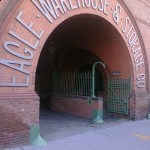 . I had been aware of the Eagle Warehouse for most of my life but had never made the connection that the Brooklyn Daily Eagle, which I was aware of, was printed there, and through this course finding that Walt Whitman wrote for the Daily Eagle. You could tell that part of the building was much older than others and had been added upon over time. It was very cool to be standing on a cobblestone street listening to Jesse Merandy, a Whitman scholar, speak of Whitman. As we attempted to go to our final stop, the Fulton Pier, it was closed due to a film shoot, so we wrapped up the tour there. Some of us went for pizza and some of us went back to school. I returned the next day to the Fulton Pier and stood upon the Pier, closed my eyes, and tried to imagine what it must have been like 150 years ago. Then I read the railing that had embedded in it the words of Whitman
. I had been aware of the Eagle Warehouse for most of my life but had never made the connection that the Brooklyn Daily Eagle, which I was aware of, was printed there, and through this course finding that Walt Whitman wrote for the Daily Eagle. You could tell that part of the building was much older than others and had been added upon over time. It was very cool to be standing on a cobblestone street listening to Jesse Merandy, a Whitman scholar, speak of Whitman. As we attempted to go to our final stop, the Fulton Pier, it was closed due to a film shoot, so we wrapped up the tour there. Some of us went for pizza and some of us went back to school. I returned the next day to the Fulton Pier and stood upon the Pier, closed my eyes, and tried to imagine what it must have been like 150 years ago. Then I read the railing that had embedded in it the words of Whitman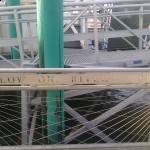
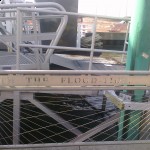
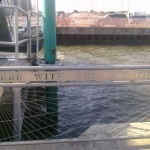
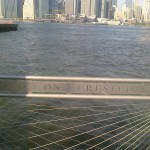
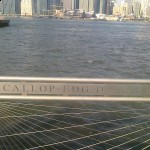
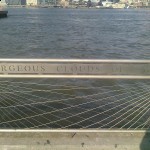
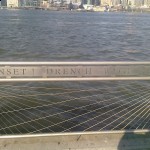
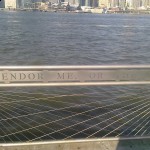
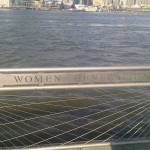
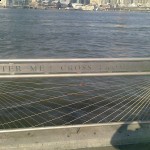
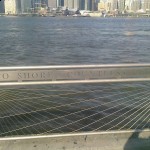
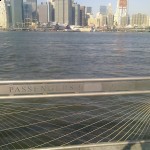
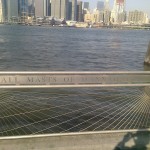
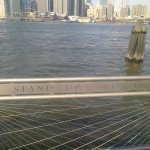
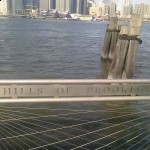

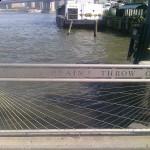
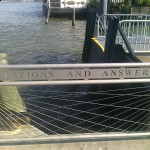 .
.